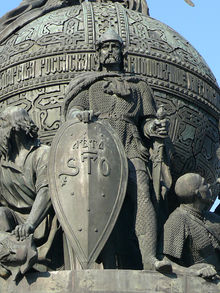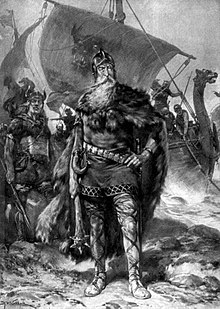Rurik: Difference between revisions
Tag: AWB |
83.227.86.57 (talk) No edit summary Tag: Reverted |
||
| Line 15: | Line 15: | ||
| issue = [[Igor of Kiev|Igor]] |
| issue = [[Igor of Kiev|Igor]] |
||
| dynasty = [[Rurikids|Rurik]] |
| dynasty = [[Rurikids|Rurik]] |
||
| father = |
| father = [[Björn Ironside]] |
||
| mother = |
| mother = |
||
| birth_date = |
| birth_date = |
||
Revision as of 10:33, 26 October 2024
| Rurik | |
|---|---|
| Prince of Novgorod | |
 Rurik on the 19th-century "Millennium of Russia" monument in Veliky Novgorod | |
| Reign | 862–879[a] |
| Successor | Oleg |
| Died | 879[a] Novgorod |
| Issue | Igor |
| Dynasty | Rurik |
| Father | Björn Ironside |
| Religion | Norse paganism |
Rurik (also spelled Rorik, Riurik or Ryurik;[1][2][3][4] Church Slavonic: Рюрикъ, romanized: Rjurikŭ;[5][b] Old Norse: Hrøríkʀ; died 879)[6][7][a] was a Varangian chieftain of the Rus' who, according to tradition, was invited to reign in Novgorod in the year 862.[1][10] The Primary Chronicle states that Rurik was succeeded by his kinsman Oleg who was regent for his infant son Igor.
Traditionally, Rurik has been considered the founder of the Rurik dynasty, which was the ruling dynasty of Kievan Rus' and its principalities, and ultimately the Tsardom of Russia, until the death of Feodor I in 1598.
Life
The earliest mention of Rurik is contained in the Primary Chronicle, traditionally ascribed to Nestor and compiled in c. 1113,[11] which states that East Slavic and Finnic tribes in 860–862 (including the Chuds, Slovenes, Krivichs, Meryans and Ves) "drove the Varangians back beyond the sea, refused to pay them tribute, and set out to govern themselves".[12] Afterwards the tribes started fighting each other and decided to invite the Varangians, led by Rurik, to reestablish order. Rurik came along with his younger brothers Sineus and Truvor and a large retinue.[1]
According to the chronicle, Rurik was one of the Rus', a Varangian tribe. Most historians believe that the Rus' were of Scandinavian origin,[13] more specifically from what is currently coastal eastern Sweden around the eighth century.[14] According to the prevalent theory, the name Rus' is derived from an Old Norse term for "the men who row", from an older name for the Swedish coastal area of Roslagen.[15][16]
Sineus established himself at Beloozero, and Truvor at the town of Izborsk. Truvor and Sineus died shortly after the establishment of their territories,[17][18] and Rurik consolidated these lands into his own territory, extending his rule in northern Russia.[1] Askold and Dir, followers of Rurik who were sent to Constantinople, seized Kiev before launching an attack recorded in Byzantine sources for the year 860.[19][17]
The Laurentian Codex of 1377, which contains the oldest surviving version of the Primary Chronicle, states that Rurik first settled in Novgorod ("newtown"), while the Hypatian Codex of the 1420s states that Rurik first settled in Ladoga, before moving his seat of power to the newly founded city of Novgorod, a fort built not far from the source of the Volkhov River, where he stayed until his death.[18][20][21][22]
Rurik is said to have remained in power until his death some time in the 870s.[a] On his deathbed, Rurik bequeathed his realm to Oleg, who belonged to his kin, and entrusted to Oleg's hands his son Igor, for he was very young. Oleg moved the capital to Kiev (by murdering the then-rulers and taking the city) and founded the state of Kievan Rus', which was ruled by Rurik's successors (his son Igor and Igor's descendants). The state persisted until the Mongol invasion in 1240.
Legacy
Rurik does not appear in the regnal list in the opening section of the Hypatian Codex (compiled c. 1425); the list of knyazi ("princes") of Kiev starts with "Dir and Askold", followed by "Oleg", and then "Igor".[23]
The Rurikids were the ruling dynasty of Kievan Rus', and ultimately the Tsardom of Russia, until 1598, and numerous noble families claim male-line descent from Rurik. The last Rurikid to rule Russia as tsar was Vasily IV,[24] who reigned until 1610 and was from the House of Shuysky. The Romanovs were also related to the descendants of Rurik through marriage. The descendants of the princely families allegedly inherited from Rurik are still living.[25]
The king Michał Korybut Wiśniowiecki reigned in the Polish–Lithuanian Commonwealth until 1673; a member of the House of Wiśniowiecki, who traditionally traced their descent to the Gediminids, recent studies side with a Rurikid origin of the House of Zbaraski and its cadet branches including the House of Wiśniowiecki.[26][27]
Alternative theories

The name Rurik is a form of the Old Norse name Hrœrekr.[28] Rorik of Dorestad was a member of one of two competing families reported by the Frankish chroniclers as having ruled the nascent Danish kingdom at Hedeby. He may have been a nephew of king Harald Klak. He is mentioned as receiving lands in Friesland from Emperor Louis I. He plundered neighbouring lands: he took Dorestad in 850, attacked Hedeby in 857, and looted Bremen in 859, while his own lands were ravaged in his absence. The Emperor was enraged and stripped him of all his possessions in 860. After that, Rorik disappears from western sources for a considerable period of time. In 862, according to Russian sources, Rurik arrived in the eastern Baltic and built the fortress of Ladoga. Later he moved to Novgorod.[citation needed]
Rorik of Dorestad reappeared in Frankish chronicles in 870, when his Friesland demesne was returned to him by Charles the Bald. In 882, Rorik is mentioned as dead (without a specific date of death).[citation needed] The Primary Chronicle places the death of Rurik of Novgorod in 879,[29] three years earlier than the Frankish chronicles. According to western sources, the ruler of Friesland was converted to Christianity by the Franks.[citation needed]
The idea of identifying Rurik of Rus' with Rorik of Dorestad was revived by the anti-Normanists Boris Rybakov and Anatoly H. Kirpichnikov in the mid-20th century,[30] but Alexander Nazarenko and other scholars have objected to it.[31]
Gallery
- Image of Rurik in the "Tsar's titularnik" (1672)
- Rurik and his brothers Sineus and Truvor arrive at Ladoga. Painted by Viktor Vasnetsov (c. 1913)
Notes
References
- ^ a b c d The Oxford illustrated history of the Vikings. Oxford [England]: Oxford University Press. 1997. pp. 138–139. ISBN 9780192854346.
- ^ Obolensky, Dmitri (1990). The Russian chronicles : a thousand years that changed the world: from the beginnings of the Land of Rus to the new revolution of Glasnost today. London: Century. p. 32. ISBN 9780712637640.
- ^ Harris, Zena and Ryan, Nonna (2004). "The Inconsistencies of History: Vikings And Rurik". New Zealand Slavonic Journal. 38: 105–130. ISSN 0028-8683. JSTOR 40922182. Archived from the original on 3 December 2021. Retrieved 3 December 2021.
- ^ Lotha, Gloria. "Rurik | Norse leader | Britannica". britannica.com. Archived from the original on 11 October 2014. Retrieved 9 March 2023.
- ^ Клосс, Борис (15 May 2022). Полное собрание русских летописей. Том 1. Лаврентьевская летопись (in Russian). Litres. pp. 19–20. ISBN 978-5-04-107383-1. Archived from the original on 23 July 2023. Retrieved 21 July 2023.
- ^ Franklin, Simon and Shepard, Jonathan (6 June 2014). The Emergence of Russia 750-1200. Routledge. p. 57. ISBN 978-1-317-87224-5.
- ^ Jakobsson, Sverrir (14 October 2020). The Varangians: In God's Holy Fire. Springer Nature. p. 64. ISBN 978-3-030-53797-5.
- ^ Ostrowski 2018, p. 46.
- ^ Ostrowski 2018, p. 42.
- ^ Perrie, Maureen (2006). The Cambridge History of Russia. Volume 1. From Early Rus' to 1689. Cambridge: Cambridge University Press. pp. 2, 47–48. ISBN 1107639425.
- ^ Langer, Lawrence N. (2021). Historical dictionary of medieval Russia (Second ed.). Lanham. p. 145. ISBN 9781538119426.
{{cite book}}: CS1 maint: location missing publisher (link) - ^ Mägi, Marika (2018). In Austrvegr. Boston: BRILL. p. 207. ISBN 9789004363816.
- ^ Wickham, Chris (2016). Medieval Europe. New Haven. p. 175. ISBN 9780300208344.
{{cite book}}: CS1 maint: location missing publisher (link) - ^ "The Vikings at home". History Extra. 24 September 2012. Archived from the original on 4 May 2020. Retrieved 26 February 2021.
- Mark, Joshua J. (3 December 2018). "Kievan Rus". World History Encyclopedia. Archived from the original on 14 April 2021. Retrieved 23 April 2021.
- Sorabella, Jean (October 2002). Heilbrunn Timeline of Art History: The Vikings (780–1100). New York: Metropolitan Museum of Art. Archived from the original on 23 April 2020. Retrieved 26 February 2021.
- ^ Blöndal, Sigfús (1978). The Varangians of Byzantium. Cambridge University Press. p. 1. ISBN 9780521035521. Archived from the original on 14 April 2023. Retrieved 2 February 2014.
- ^ Brink, Stefan. "Who were the Vikings?', in The Viking World Archived 14 April 2023 at the Wayback Machine, ed. by Stefan Brink and Neil Price (Abingdon: Routledge, 2008), pp. 4–10 (pp. 6–7).
- ^ a b Langer, Lawrence N. (2021). Historical dictionary of medieval Russia (Second ed.). Lanham. p. 176. ISBN 9781538119426.
{{cite book}}: CS1 maint: location missing publisher (link) - ^ a b Dixon-Kennedy, Mike (1998). Encyclopedia of Russian & Slavic myth and legend. Santa Barbara, Calif.: ABC-CLIO. p. 232. ISBN 9781576070635.
- ^ Duczko, Wladyslaw (2004). Viking Rus: studies on the presence of Scandinavians in Eastern Europe. Leiden: Brill. p. 204. ISBN 9789004138742.
- ^ The Cambridge history of Russian literature (Rev. ed.). Cambridge: Cambridge University Press. 1992. pp. 12–13. ISBN 9780521425674.
- ^ Jones, Gwyn (1984). A history of the Vikings (Revised ed.). Oxford. p. 246. ISBN 9780192801340.
{{cite book}}: CS1 maint: location missing publisher (link) - ^ Somerville, Angus A.; Mcdonald, Andrew R. (2020). The Viking age : a reader (Third ed.). Toronto. p. 282. ISBN 9781487570477.
{{cite book}}: CS1 maint: location missing publisher (link) - ^ Ostrowski 2018, p. 36.
- ^ Raffensperger, Christian and Ingham, Norman W.. "Rurik and the First Rurikids", The American Genealogist, 82 (2007), 1–13, 111–119.
- ^ Kalmistopiiri, julkaissut (27 October 2021). "Ruhtinas ja ruhtinaan pojat – paljastavatko geenit Venäjän perustajana pidetyn Rurikin alkuperän?". KALMISTOPIIRI (in Finnish). Archived from the original on 26 September 2022. Retrieved 3 September 2022.
- ^ Księstwa Rzeczpospolitej: państwo magnackie jako region polityczny
- ^ Кралюк, Петро (4 April 2020). Півтори тисячі років разом - Спільна історія українців і тюркських народів (in Ukrainian). Glagoslav Publications. ISBN 978-966-03-8155-1.
- ^ Omeljan Pritsak, "Rus'", in Medieval Scandinavia: An Encyclopedia Archived 26 April 2023 at the Wayback Machine, ed. Phillip Pulsiano (New York: Garland, 1993), pp. 555–56.
- ^ Ostrowski 2018, p. 40.
- ^ Kirpichnikov, Anatoly H. "Сказание о призвании варягов. Анализ и возможности источника". Первые скандинавские чтения, СПб; 1997; ch. 7–18.
- ^ Nazarenko, Alexander. "Rjurik и Riis Th., Rorik", Lexikon des Mittelalters, VII; Munich, 1995; pp. 880, 1026.
Bibliography
- Halperin, Charles J. (2022). The Rise and Demise of the Myth of the Rus' Land (PDF). Leeds: Arc Humanities Press. p. 107. ISBN 9781802700565. Retrieved 1 February 2023.
- Ostrowski, Donald (2018). "Was There a Riurikid Dynasty in Early Rus'?". Canadian-American Slavic Studies. 52 (1): 30–49. doi:10.1163/22102396-05201009.



